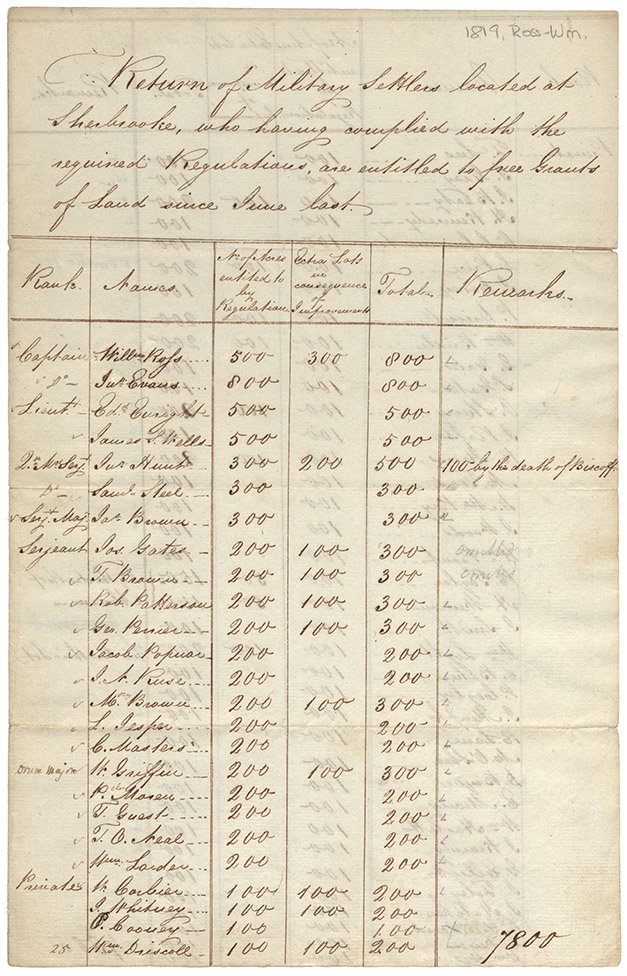Nova Scotia Archives
New Ross: From Family to Community
Results 1 to 5 of 5 from your search: Land Papers
Return of military settlers located at Sherbrooke
Date: 24 September 1819
Reference: Land Papers Nova Scotia Archives RG 20 Series A volume 78 – 1819 Ross, William and others
Note: “Return of military settlers located at Sherbrooke, who having complied with the required regulations are entitled to free grants of land since June last.”
With the conclusion of the European wars against Napoleon the Nova Scotia Fencibles were disbanded on July 24th 1816. Many accepted the offer of land in the settlements along the planned road through the center of the province from Halifax to Annapolis. In August William Ross started at Gold River with 172 disbanded soldiers and made his way into the interior where the settlement was planned about Lakes Lawson and Darling.
When land grants were prepared in 1819 this list, made on 24th September, showed only 68 families remained at the settlement. The size of the lots they would be granted was based on their former military rank. 5 days later, on 29th September 1819, Lord Dalhousie approved of the allocation of land.
Warrant to Survey, 1819, William Ross and 67 others
Date: 3 October 1819
Reference: Land Papers Nova Scotia Archives RG 20 Series A volume 78 – 1819 Ross, William and others
Note: “By his Excellency Lieutenant General the Right Honorable George Earl of Dalhousie….”
After approving in principle of the land grant, and with the advice of his Council, an order or warrant would be issued to the Surveyor-General of Lands, (Charles Morris), that provided the authority to survey and lay out lands to satisfy the proposed grant. In this case the Warrant repeats the names and land allocation by rank to the disbanded soldiers as outlined in the “Return of military settlers…”.
Draft land grant, 1819, William Ross and 67 others
Date: 26 October 1819
Reference: Land Papers Nova Scotia Archives RG 20 Series A volume 78 – 1819 Ross, William and others
Note: “Nova Scotia. George the Third by the Grace of God of the United Kingdom of Great-Britain and Ireland…..”.
The draft land grant links each grantee to a numbered lot and identifies the size of the lot. In some cases, the lot is further described in terms of its bounds. The process for granting land in Nova Scotia included a draft grant which set conditions of settlement and agricultural improvement that would have to be met prior to the grant being finalized. Although in this instance settlers had been on the lands since the summer of 1816, delays in escheating unclaimed Loyalist land grants in the area had delayed the process of grants to the disbanded soldiers.
Land grant, 1819, William Ross and 67 others
Date: 22 December 1819
Reference: Land Papers Nova Scotia Archives RG 20 Series A volume 78 – 1819 Ross, William and others
Note: “Nova Scotia. George the Third by the Grace of God of the United Kingdom of Great-Britain and Ireland…..”.
This document is the actual land grant as signed by the Secretary of the Province, Rupert George, and Richard John Uniacke, on behalf of the Receiver General, to indicate the payment of the appropriate fees. Like the previous document, the land grant names each person receiving land, the amount of the land and its general bounds, additionally this document has been annotated to make the lot numbers more prominent.
Map of land grant made by Charles Morris
Date: 22 December 1819
Reference: Land Papers Nova Scotia Archives Map 2015-038
Note: This map was transferred from the Ross Farm Museum to the Archives in 2015. It, and an original land grant, would have been given to William Ross at the time the land grant was officially made in December of 1819. It clearly shows that the settlement was arranged with each lot having frontage on the Gold River or on the “Public road one hundred feet wide heading thro Hammonds Plains from the Town of Halifax to Annal 100 foot wide road from the Town of Halifax to Annap[olis]”. The scale of the map is 40 chains (half a mile) to one inch. The road from Chester to Windsor appears on the left edge of the map.




